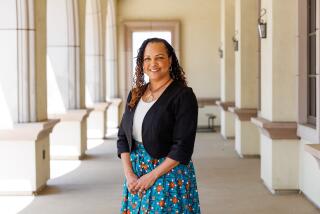A Day’s New Challenges : Hands-On Lessons Teach Children Respect for the Disabled
- Share via
Six-year-old Jeffrey Marovitz squeezed his eyes shut and hesitantly tiptoed down the hall of his Simi Valley elementary school, tapping a red-and-white cane on the floor while extending his free hand protectively in front of him.
Jeffrey isn’t blind. But he found out what it’s like to be sightless Tuesday during the Ability Awareness Fair at Garden Grove Elementary School, a unique campus where orthopedically handicapped students take classes with non-disabled children for part of the school day.
Non-disabled youngsters throughout the school tried on various disabilities during the third annual awareness fair. They discovered the challenge of driving a wheelchair through a narrow space, communicating with sign language and completing chores with one hand instead of two.
“It’s weird,” Jeffrey said of maneuvering through familiar hallways using a cane to see where he was going. “It would be hard for me to do it all the time.”
Once they have walked in another person’s shoes, the children tend to have more empathy for people with disabilities, said Assistant Principal Judy Canavarro.
“I think it’s something they’ll carry with them all their lives,” Canavarro said.
Over the next two days, all of the school’s more than 500 regular education students will participate in the fair’s activities, often side by side with some of the school’s 125 students with physical and developmental disabilities.
In the process, teachers hope the children will learn that behind the disability is a whole human being who deserves respect and friendship, Principal Elroy Peterson said.
“We don’t want children in wheelchairs being treated as things,” Peterson said.
Parent Donna Prenta said the fair is important because it teaches children about disabilities at an age when they are receptive to the message. Young people tend to become more compassionate in the process, Prenta said.
“If you don’t know about something, you fear it,” said Prenta, whose 2-year-old daughter Laura is physically and developmentally disabled. “But if you explore things, it takes the mystery out of it. It teaches acceptance.”
From the seat of a wheelchair, sixth-grader Daryl Mosher couldn’t reach the faucet to draw a cup of water after successfully steering through an obstacle course of orange cones. The exercise brought home the message, he said.
“I felt kind of helpless,” Daryl, 11, said. “I’ll probably treat someone in a wheelchair better now because I know what it feels like to be disabled.”
Fifth-grader Shannon Beers said she developed respect for disabled people after she had trouble steering clear of the orange cones and then struggled to open a bathroom door without sliding away.
“The disabled have to go through a lot,” Shannon, 10, said. “It’s a lot easier to walk.”
Garden Grove physical therapist Rick Nagasawa pointed out that the non-disabled students were the same fun-loving children whether they sat in the chair or stepped out of it. The same is true of disabled children.
“They can do fun things, but they just do it from a chair,” Nagasawa said.
More to Read
Sign up for Essential California
The most important California stories and recommendations in your inbox every morning.
You may occasionally receive promotional content from the Los Angeles Times.













